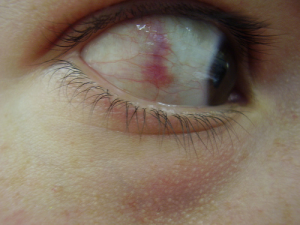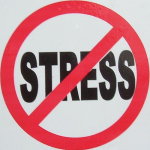
3 Tips on Staying Healthy At Work

by drburt

by drburt
This is a Guest Post by Kimi James. – Bones
There’s a saying that goes, “Sticks and stones may break my bones” and isn’t that true? When an object that’s ten times greater than your body mass is thrown at you, your body probably would get bruised or worse broken. I think we take the bones that make up our body for granted not realizing that the very thing that makes us up is the same thing we need to take care of to keep us in shape, in form, and in health.
When you wake in the mornings and rise from the bed, it took your meta-tarsals, your phalanges, your tibia, your femur, your fibula, your gluteus maximus (muscle), and many other bones to work in order for you to do just that one action.
Before I get ahead of myself and recite an in-depth physiological motion involved with just getting up, I want to emphasize four points to help you stay on track when dealing with your bones.
Bones are necessary to get around in life and a part of daily living. How would you manage to do the tasks like picking up a fork or tie a shoe lace if your femur or your phalanges no longer worked? Sadly, some people face that situation yet amazingly and with resilience still go on. But you have your limbs, your bones in tact, so use them and use them well. Your bones deserve the loving care it does so it works to keep you around. Drive less, walk more.
by drburt
 This is a guest post by Ayrsley Solutions.
This is a guest post by Ayrsley Solutions.
In life, we experience a multitude of emotions ranging from positive to negative. What a lot of us don’t realize is that each emotion that we experience makes a profound impact on our health as well as our psyche.
Stress is one of the factors that affects us emotionally and physically. Stress will cause the chain of the biochemical reactions in a our body. The hypothalamic-pituitary-adrenal axis (HPA or HTPA axis), also known as the limbic-hypothalamic-pituitary-adrenal axis (LHPA axis) and, occasionally, as thehypothalamic-pituitary-adrenal-gonadotropic axis, is a complex set of direct influences and feedback interactions among the hypothalamus, the pituitary gland (a pea-shaped structure located below the hypothalamus), and the adrenal (also called “suprarenal”) glands (small, conical organs on top of the kidneys).
The interactions among these organs constitute the HPA axis, a major part of the neuroendocrine system that controls reactions to stress and regulates many body processes, includingdigestion, the immune system, mood and emotions, sexuality, and energy storage and expenditure. A wide variety of species, from the most ancient organisms to humans, share components of the HPA axis. It is the common mechanism for interactions among glands, hormones, and parts of the midbrain that mediate the general adaptation syndrome.
The steroids that are released from the adrenal glands during stress ends up growing the body fat; this fat is also referred to as: “belly fat”, “muffin top”, and “pooch”. The medical term would be an “adipose tissue”.
As part of the life cycle, we are continually burning energy and aging; however, being under stress expedites these changes in our bodies. Stress becomes an environmental toxin that causes damage and increase oxidant levels which results in slowing down our bodies’ cells and repair mechanisms. This ultimately leads to a prolonged aging process that appears on our face and body.
So what should a person do to help decrease the long term effects of stress on our body in a non-evasive manner?
1. Keep hydrated.
As we get older, we tend to lean away from drinking lots of water. But did you know that it only takes 10% of dehydration for your metabolism to slow down. When your metabolism slows down, unnecessary weight gain occurs.
2. Take lukewarm showers.
A lot of people don’t enjoy hearing this one, especially if they are addicted to taking nice hot showers. But, taking hot showers strips away the fat barrier from your skin; therefore leading to dry and crackling skin. Also, another thing that we recommend is that if your muscles are inflamed, taking a hot shower is the last thing that you want to do. Why? Because think of it this way, when your muscles are inflamed, you don’t have to touch your skin to feel the heat dissipating. You can’t put out a fire with fire, correct? With that being said, when you take a hot shower with inflamed muscles, you will feel good for about an hour or so; but we all know that feeling is only temporary. Therefore, when taking a lukewarm to cold showers, not only you are preserving your skin but you are also reducing the muscle inflammation.
3. Vitamin A versus Vitamin E
Vitamin A, also known as Retinol, is a vitamin combined with Retinal and 4 Carotenes including Beta Carotene. Vitamin A has been scientifically proven to increase chemicals that reverse wrinkles!
Vitamin E, also known as Tocopherol, is a vitamin combined with 8 Fat Soluble Compounds including Tocotrienol. Scientific studies have shown that people that take Vitamin E supplements do add longevity to their lives. Although, Vitamin E is good for you, however, the best form to consume Vitamin E is through food such as almonds, wheat germ, and avocado instead of the pill form.
The extension cord of your brain is your spinal cord. Your spinal cord is encased inside of your spine that is made of up 24 articulating bones known as your vertebra (vertebrae). The extension of your spinal cord are your spinal nerves that protrude from in-between each vertebra. The spinal nerves encompass your entire body, attaching itself to muscles, tissues, and organs. This is referred to as the body’s “information highway.”
When your vertebra is misaligned, it causes a misalignment which applies pressure and results in nerve interference.
Remember, the brain expresses stress to your adrenal glands and your adrenals glands delivers the expression throughout your entire body. The 9th nerve in your thoracic is the nerve that supplies your adrenal glands. If there is an interruption of communication between the brain and your adrenal glands during stress, it could lead to other more serious health related problems
By seeing a Doctor of Chiropractic, this nerve interference can be resolved and maintained to ensure that your body is working at its maximum.
As people, we identify stress to be a normal part of life while ignoring the serious effects that it can cause to our body. The term stress should not be limited to the definition as outside or environmental factors; for our body also experience stress when we are not feeling well due to a cold. Always bear in mind, that how you handle and overcome stress will become apparent on your body.
If you have anything to add to this post, please feel free to Post a comment or share your thoughts through Facebook, Twitter, or comment section below to join the conversation.
by drburt
Could Your Building Be Making You Sick?
According to the EPA there are roughly 80,000 chemicals rampant in our society and the biggest culprit is architectural products. Architectural, industrial maintenance coatings and household cleaning products are responsible for 38 tons of emissions a day. Since the oil embargo of the 1970swe have chosen to create buildings that act as a well sealed cocoon, which if not designed correctly could become very toxic for the occupants.
Indoor pollutants can be roughly divided into 6 categories:
Volatile Organic Compounds:
In simple terms VOCs are chemicals containing carbon, except for a few exceptions, these are volatile because they don’t need extraordinary conditioned to go from solid/liquid to gaseous. It could happen under very normal temperatures and conditions like any typical indoor or outdoor environment. These chemicals are used in everything from paint, carpeting, and upholstery to our food products like decaffeinated tea or coffee.
I know, you see a lot of labels with Zero-Voc plastered on them, you might want to look further if these products are really devoid of all glycol or petrochemicals ingredients. Health impacts of VOCs range from headaches, nausea, all the way to liver and respiratory problems.
Toxic by products of Combustion:
These are byproducts of processes such as furnace burning or water heating and could be carbon dioxide, carbon monoxide or particles etc. Exposure doesn’t necessary mean death it could cause headaches, nausea, fatigue, sleepiness etc.
Mold
All you need for mold to develop is presence of oxygen, a good combination of humidity and temperature and any nutrition source which could also be cellulose based insulation and of course wood is an obvious one. Some of the fungi that cause mold also produce VOCs as a byproduct when they’re decaying a material for nutrition.
Pesticides
Are usually included in products to give them shelf life or to give them antimicrobial products. Formaldehyde is commonly used for that, but you never see it mentioned on label.
Naturally Occurring Pollutants
Range from dust, dust particles, pollen to radon which is decaying of radium in the earth’s crust and seeps through poor foundation or construction details. Health impacts range from respiratory problems, allergies all the way to cancer.
Electromagnetic field pollutions
Electromagnetic field pollution occurs every time electricity is generated. We are surrounded by it with wireless networks, power lines, computer screens, microwave ovens, TVs, lighting, electrical outlets, cordless phones, wiring, appliances, etc. Exposure to EMFs of specific equencies/intensities has been linked to depression, loss of energy, irritability, inability to concentrate, chronic fatigue, headaches, weakened immune system, cancer, brain tumors, Alzheimer’s, autism, childhood leukemia, birth defects, accelerated aging and miscarriages.
You can subscribe to Hafsa Burt’s BLOG HBAARCHITECTS to continue the discussion.
Mrs. Burt is the principal owner and architect of a bay area base Architecture, Interior Design and Planning firm. An environmentalist, she actively advocates the 2030 challenge and is a huge proponent of holistic high performance buildings. She specializes in Indoor air quality and targets “healthy buildings” in her practice and design philosophy. As a principal of a small size firm, she is actively involved in all projects with a commitment to the practice of architecture as a collaborative, innovative enterprise.